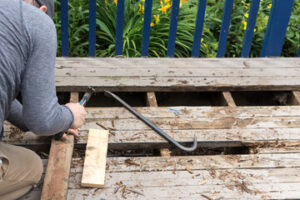If you spot any rotting boards, have a deck repair expert do a full inspection. If the rot is extensive, they might recommend a complete rebuild instead of repairs. Contact Mount Joy Company LLC for professional help.

Insect damage is another concern. Watch out for wood-loving insects like termites and carpenter ants. Also, look for aphids and other bugs.
Even a well-maintained deck requires periodic repairs. Simple timely repairs like securing loose railings or replacing a rotten stair tread can prevent more expensive, time-consuming and complex problems in the future. These fixes are also important for safety reasons. If you plan to tackle a more extensive repair job yourself, such as a complete deck replacement, it is best to contact a professional so they can provide the proper materials and ensure that the installation is done correctly.
Wood Rot and Termite Infestation: Moisture accumulation, especially in damp climates, causes wood rot and attracts insects. Proper sealing and regular inspections help prevent these issues.
Cracks and Splinters: Sunlight, rain, and frequent use cause the fibers in wood to weaken over time. These weakened fibers can create jagged splinters. A light sanding and application of a protective finish can reduce splintering.
Wobbly Stairs: Loose screws, deteriorating connections, and structural shifts can cause unstable railings and stairs. Structural shifting can be corrected with joist bolts and anchors. Loose screws are typically a result of constant use and weather exposure, which causes vibrations that cause them to loosen over time. Frequent use of a deck and improper fastener selection contributes to this issue as well.
Discolored Deck Stain: UV rays from the sun can fade the color of your deck stain over time. Regular cleaning and reapplication of stain helps restore the color of your deck.
If you find that your deck is looking dull and worn out, it may be time for a new coat of stain or a full replacement. Refinishing your deck will not only improve its look, but it can also extend its life and protect against rot and insect infestations.
Check Their Rating on Angie’s List
While decks are a great place to gather with family and friends, they can also become a hub for termite damage, wood rot, and other structural issues. As such, it’s important to check on your deck regularly and make repairs as needed. While many homeowners can take on simple tasks, such as refinishing or staining, more substantial repair work requires a professional. Before hiring a contractor, you should check their reputation on Angie’s List to ensure you’re getting the best value for your money.
Before beginning the deck repair process, it is important to have all your tools and materials ready. You will need safety glasses to protect your eyes from debris, a dust mask to help you breathe while working on the deck, and hearing protection to muffle power tool noise. In addition, you’ll need a pry bar or claw hammer to remove any deck boards that are splintered, warped, or rotten. Be careful not to damage any joists or railings in the process.
After removing any damaged components, it’s time to start the actual repair work. Begin by sanding the deck and cleaning it to get rid of any mildew or mold. Then, you’ll need to apply a fresh coat of stain or sealant to prevent future deterioration.
Lastly, it’s essential to use fasteners that are designed for outdoor use. Otherwise, you risk corrosion and a loss of the structural integrity of your deck. Also, make sure to replace any nails or screws that have been loosened by weather exposure and vibrations from foot traffic.
Read Reviews from Previous Customers
A well-crafted deck provides an ideal space for relaxation and entertainment. But as with any outdoor living space, it requires care and maintenance to remain in good condition. This is why it’s important to perform regular inspections and make timely repairs to keep your deck in top shape.
A comprehensive deck inspection includes both the surface and substructure to assess the overall condition of the structure. Then, you can determine whether to repair or replace the deck.
Repairs are generally less expensive than replacing the entire deck, especially if the damage is localized and minor. But if the condition of your deck is significantly deteriorating, a complete replacement may be more cost-effective in the long run.
The age of your deck and the severity of the damage are major factors in determining whether to repair or replace it. Older decks tend to show more signs of wear and tear than newer ones. A thorough deck repair can address cosmetic issues like faded or stained boards.
But if your deck has structural integrity problems, such as wood rot or insect infestation, it’s likely time to consider a complete replacement. Neglecting these issues can compromise your deck’s safety and lead to costly structural repairs in the future.
Get a Fair Cost Estimate
When hiring a professional contractor to make repairs, homeowners should expect to pay about $10 to $55 per square foot. This includes labor, supplies, and cleanup costs. Many factors influence the cost, including deck size, location, and the type of repair required.
For example, if the deck needs structural work such as replacing or repairing joists, the price will be higher than a simple repair job. Joists are the beams that support the deck and can be very expensive to replace if they are damaged or rotted. Other costly repairs include removing and replacing deck boards, cleaning the railings, and staining the wood.
The age of the deck is another important factor in determining repair costs. An older deck may need more frequent and extensive repairs, which can add up over time. Decks with features like built-in seating, lighting, and pergolas can also be more costly to repair than those without these amenities.
A professional inspection can help you get a better idea of the total costs involved with your repair project. In addition, this is a good time to ask about any additional services or charges you might be expected to pay for, such as demolition fees or permit costs. In some cases, a permit is required for a major deck repair or replacement, and this can add up to several thousand dollars. Getting a fair and accurate estimate is essential to making the right decision about whether to repair or replace your deck. Investing in regular maintenance and dealing with issues promptly can keep repairs to a minimum and save you money in the long run. However, if your deck has reached the end of its expected lifespan or is in need of extensive repairs, replacement may be a wise investment.
Hire a Professional
Aside from water damage, another common reason homeowners need to hire a deck repair contractor is for structural integrity issues. Moisture is a major cause of deterioration, and it can cause wood to swell, warp, or rot. Proper drainage channels, routine inspections, and preventive treatments can help to minimize moisture problems. A professional can also inspect the ledger board (the piece of wood that connects the deck to your house) and make sure it is strong, secure, and not moving.
Loose boards can be a safety hazard, especially for children and pets. In addition, they can become tripping hazards. If a few loose boards are the only issue, a repair may be sufficient, but if it is a widespread problem, it could require a full replacement.
Other signs that your deck is in need of repair include cracks and splinters. While these may seem minor, it is important to note that they are an indicator of underlying issues that need to be addressed quickly. If left untreated, these issues can lead to wood rot and mold growth that can affect the stability of your deck and the safety of your family and friends.
Hiring a professional deck repair company is usually more cost-effective than trying to do the work yourself. In addition to saving on equipment rentals and labor costs, a professional can guarantee the quality of their work and may offer a warranty in case something goes wrong. They can also ensure that any permits are obtained and that all work is up to code. They are also often able to provide expert advice on how to properly care for your deck and avoid future repairs.

